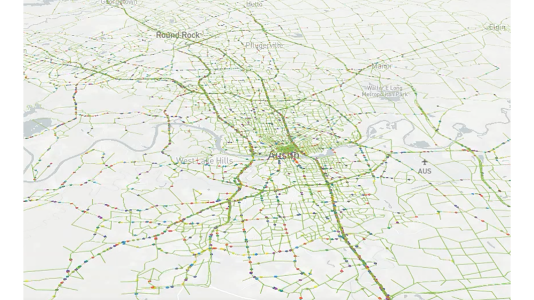
After developing their high fidelity predictive transportation system model, POLARIS, researchers at the U.S. Department of Energy’s (DOE) Argonne National Laboratory recently hit a crescendo by simulating the impacts of a multitude of potential future transportation scenarios across the Chicago metropolitan area.
Now, like any good band, they’re on to the next city.
“Our integrated modeling workflow provided unique insights into the impact of new technologies on energy and mobility, including some potential negative effects of driverless vehicles, for the Chicago Metropolitan area,” said Joshua Auld, a technical manager for Transportation Systems and Mobility at Argonne’s Center for Transportation Research. “However, expanding the findings to other metropolitan areas is critical since each area has its own unique characteristics, culture, land form and transportation assets.”
“Building detailed travel behavior models is critical to properly predict how individuals travel and respond to new mobility technologies,” Auld said. “We simulate large-scale urban and metropolitan areas, including all of the transport modes and travel episodes for every resident in the area, to understand how users interact in the system and how different technologies impact the overall system performance.”
As part of DOE’s multi-lab Systems and Modeling for Accelerated Research in Transportation (SMART) Mobility Consortium, Argonne developed POLARIS to be able to dial up and down a large number of inputs — land use, electric vehicle (EV) charging, passenger and goods movement, traveler behavior — and model what happens to vehicle miles traveled, congestion, vehicle hours traveled, energy, cost, greenhouse gases as a result.
To develop the Chicago model, they worked with multiple organizations, including the city’s Department of Transportation, transit and planning agencies, universities and non-profits. They’re keeping that same partnership approach as they expand to Atlanta, Austin and Detroit.
“The new models will allow us to explore the impact of new transportation technologies and mobility trends across different geographies, populations, and infrastructure,” Auld said. “The project expands the scope of analysis and will help to potentially generalize findings from the SMART Mobility research program.”
POLARIS is a travel behavior, traffic flow and network operations simulation tool where all of these aspects of the transportation system for a region are modeled dynamically, in a fully integrated manner, as travelers respond in modeled real-time to changing network conditions, control signals and the actions of other travelers and management authorities.
“Building detailed travel behavior models is critical to properly predict how individuals travel and respond to new mobility technologies,” Auld said. “We simulate large-scale urban and metropolitan areas, including all of the transport modes and travel episodes for every resident in the area, to understand how users interact in the system and how different technologies impact the overall system performance.”
In Atlanta, researchers are working with Georgia Tech and the Atlanta Regional Commission; in Austin, it’s the University of Texas-Austin and the Capital Area Metropolitan Organization. In Detroit, developers are working with the Ford Motor Company.
The ultimate goals of the project are to deploy the tools to other researchers and stakeholders to support future decisions and continue to bring POLARIS to new audiences in other metropolitan areas. “What I enjoy most about this project is to take all of the hard work that our team has put in to the development of the state-of-the-art POLARIS simulator and working with local stakeholders to see the model actually being deployed and demonstrating its usefulness to government agencies, planners, academics and industry,” Auld said.
The SMART Mobility Consortium is funded by the Energy Efficient Mobility Systems Program of the Vehicle Technologies Office, DOE Office of Energy Efficiency & Renewable Energy.